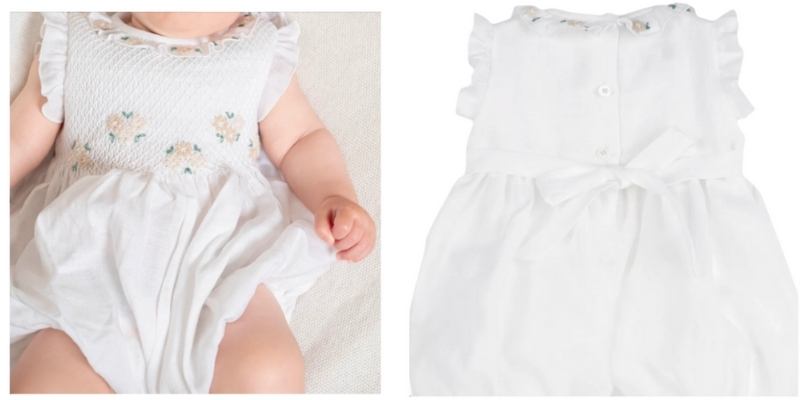Why is linen fabric perfect for children’s clothes?
Linen comes from the flax plant and it can be grown anywhere on the planet. Flax is easy to grow, requires only rainwater, and requires little to no pesticides or fertilizers to grow quickly. It is cut or pulled out of the soil, the seeds are removed by a process called “sieving” and the fibers are separated to collect the longest pieces.
Linen fabric can be considered the best and most sustainable fabric on Earth, which is particularly important if you have children. Why? Because they deserve the finest things and quality clothing falls into that category.

1. What is Linen?
Linen is a special kind of cloth that is used to create cozy and high-quality items. It is made from strong fibers found in the stems of flax plants. These fibers are very tough and can be up to three times stronger than cotton if taken care of properly.
What’s great about linen is that it lets air flow through it easily, making it a fantastic choice no matter the season. It’s especially perfect for hot summers because the light fabric helps keep your body cool. In colder months, you can wear more linen layers comfortably because it has a soft texture.
And the best part is that it always looks effortlessly beautiful, no matter the time of year!
2. Benefits of Linen Fabric for Children’s Clothes
It’s not a coincidence that many people prefer linen fabric when choosing clothes for their children. It has exceptional qualities and advantages compared to other fabrics, which we will clarify in this section.
2.1. Hypoallergenic and gentle on baby’s skin
Everyone knows that baby’s skin is sensitive, but more and more babies are experiencing skin allergies when wearing clothes made of low-quality fabrics, and no parent likes that.
Linen fabric is safe for kids with sensitive skin because it doesn’t cause allergies or make them worse. It’s made from natural fibers without any harmful chemicals or dyes. Linen also keeps bacteria and fungi from growing, preventing infections and bad smells.
Plus, it doesn’t attract dust or dirt, which can irritate the skin and eyes. So, linen is a great choice for children’s clothes, considering their delicate skin.

2.2. High durability and longevity
Linen fabric is one of the most durable fabrics available. It can withstand wear and tear from ‘hard-core’ activities like washing, drying, ironing, and folding. In fact, it becomes even softer and more absorbent after each wash, providing enhanced comfort when worn.
Linen fabric also maintains its shape and color over time, unlike other fabrics that may fade or shrink. With proper care, linen can last for many years, making it a timeless material that can be passed down from generation to generation.
2.3. Eco-friendly and sustainable
Environmentally friendly and sustainable, linen fabric is among the most eco-conscious and durable fabrics available today.
Linen plants require less water, pesticides, and fertilizers compared to other crops like cotton. In fact, they can thrive with an average of just two rainfalls per week. When harvesting, linen plants utilize every part of the plant, leaving no waste behind. Linen fabric can also be recycled or biodegraded at the end of its life cycle, reducing landfill waste.
Additionally, linen fabric has superior durability compared to other fabrics, making it a worthwhile investment for your child’s wardrobe.
3. How to Choose The Most Suitable Linen Clothes for Your Lovely Kids?
You know why other parents choose linen fabric for children’s clothing, right? And now you may be wondering how to select quality clothes for your child when there are so many options on the market, including fake and counterfeit products. So, what can you do?
- Go for brands or sellers that are well-known and trusted. They make sure their clothes are real and made well. They also use good materials and make them in a nice way.
- Check the fabric and stitching when you’re looking at the clothes. Good-quality clothes are made from strong materials like real linen. They can handle being worn and washed a lot. The fabric should feel soft and smooth, not frayed or weak. The stitching should be neat and tight with no loose threads or uneven seams. That means the clothes are well-made and less likely to fall apart.
- Read reviews from other parents or ask for recommendations. They can tell you if the clothes are good quality, durable, comfortable, and if other people like them. It’s good to listen to trusted sources who have tried the clothes before.
- Be careful when you buy clothes, especially online, because there are fake ones out there. Look for clear and accurate descriptions, detailed pictures, and fair return or exchange policies. If a deal seems too good to be true or the price is much lower than you expect, it might be a sign that the clothes are not real.

4. Care Instruction of Linen Clothes
To keep your children’s linen clothes in great condition, it’s important to follow some linen care instructions. Here are some simple tips:
- Read the label carefully
- Gentle machine wash or hand wash
- Avoid harsh chemicals
- Dry flat or hang to dry
- Iron while slightly damp
- Store linen clothes in a cool, dry place to prevent moisture buildup.
By following these simple care instructions, you can ensure that your children’s linen clothes remain in good condition, allowing them to enjoy the comfort and durability of this wonderful fabric.
Care Instructions for Your Children’s Linen Clothes
Linen fabric becomes softer and more absorbent after each wash, which is one of the reasons why we love it so much! But to make linen fabric last, you need to learn not only how to wash it but also how to iron and dry it properly. Let’s start right away.
4.1. Use the washing machine properly
We understand the temptation to throw all your clothes into the washing machine at once, but it only takes one time of mixing your jeans, linen garments, and white clothes together to learn from this mistake. Regardless of the fabric of your clothes, washing them correctly is crucial, so it’s important to sort and separate your garments by color and fabric type.
When washing linen clothing, there are some additional tips to protect the fabric.
- Read the labels on the clothes to see what the manufacturer recommends before putting them in the washing machine. Some may require hand washing or dry cleaning. If they can go in the machine, use cold water and a gentle detergent.
- Avoid overloading the machine. You should always avoid putting too much in the washing machine at once. If you do, there’s a risk of causing the garments to get tangled, leading to stretching the linen ones.
- Children’s skin is more prone to damage or irritation. Therefore, when washing linen clothes for children, it’s best to avoid using powdered detergent. It can linger in the fibers and cause skin irritation. It’s better to use a gentle liquid detergent instead.
- As for the scent of the detergent, it’s preferable to use unscented ones, as fragrances can also cause irritation and other issues for children.
- When putting them in the washing machine, use a gentle cycle and a temperature not exceeding 104 degrees F (40 degrees C) if you want the fabric to last longer.
4.2. Hand wash your children’s linen clothes
Sometimes, your clothes may need to be hand-washed, or you may simply want to do this to be more careful with your child’s outfits. So, here’s what you’ll do:
- Fill your bathtub with warm water and a gentle detergent.
- Place your linen clothes inside and let them soak in the water.
- Gently move the clothes around in the bathtub for a few minutes.
- Drain the water and rinse your items thoroughly.
- Make sure you wash the clothes long enough to remove all the soap suds.
Note: Avoid scrubbing, wringing, or twisting children’s clothes too forcefully.
4.3. Dry your children’s linen clothes carefully
Most fashion experts recommend that you hang your clothes outdoors to dry. Avoid using a high-temperature dryer as it can cause the clothes to shrink.
When hanging your clothes, use velvet hangers or at least use clothespins. These hanging options will keep your garments safe while allowing them to dry flat and prevent them from getting wrinkled.
4.4. Iron linen garments
Linen fabric is known for its natural wrinkles, so you don’t need to iron it. Some people embrace the natural wrinkles as part of the fabric’s appearance. However, deep wrinkles may not look appealing, and using an iron and ironing board becomes necessary.
When ironing linen, start by lightly misting the garment to add a bit of moisture, which helps prevent scorching. Then, make sure to set the iron to a low heat setting (not exceeding 200 degrees Celsius) as this fabric doesn’t require high heat. After completing this step, iron out those wrinkles and hang your clothes in the wardrobe.
K-Embroidery’s linen dresses are no exception. When you purchase them, it’s essential to carefully read the provided care instructions to ensure that you maintain their durability and keep them looking fresh.
5. Conclusion
Linen is the perfect choice for children’s clothing thanks to its comfort, durability and eco-friendly qualities. It offers breathable comfort, withstands wear and tear, and is sustainably produced. Linen clothing may be more expensive than cotton, but it ensures children are free of irritation and is both comfortable and environmentally responsible.

Contact K-Embroidery manager to buy high quality, cute and safe hand-sewn products for children via WhatsApp: +84855555961 to get the best price and order now!
Contact:
- Address: 5th Floor, Building No. 169 Nguyen Ngoc Vu, Cau Giay District, Hanoi
- Hotline: +84855555961
- Website: https://k-embroidery.com/
- WhatsApp: +84855555961
6. FAQs
6.1. Why is linen good for kids?
Linen is a wonderful choice for kids because it has special qualities. It naturally fights against germs, allows air to flow through, and dries fast. This means it keeps kids cool, protects them from the sun, and helps their skin stay clean and dry.
6.2. What fabric is soft and breathable?
Fabrics made from plants, like cotton, linen, and bamboo, are really soft and let air pass through. That’s why they are perfect for making clothes and bedding. Fabrics from animals, like silk and wool, are also soft and let air in. All of these fabrics keep the body cool by letting air circulate and taking away sweat.
6.3. Does linen absorb sweat?
Linen is excellent at absorbing sweat. If you wear a linen shirt and sweat a lot, it will soak up the sweat. But don’t worry, it won’t feel wet and sticky because linen is so good at drying quickly. It’s like magic! The water gets absorbed by the linen and then evaporates into the air very fast.


